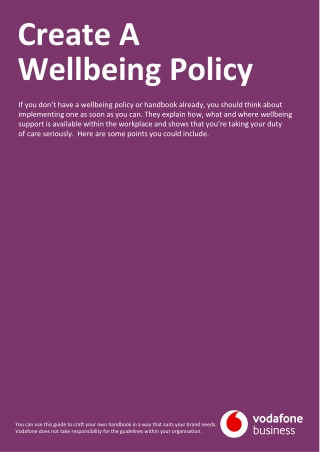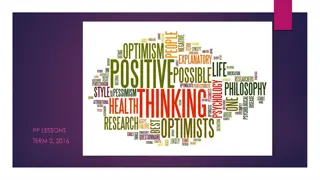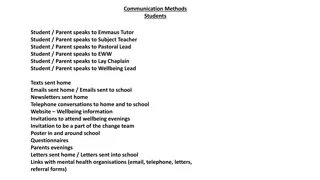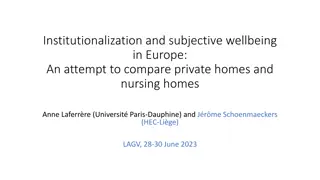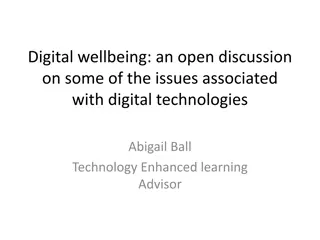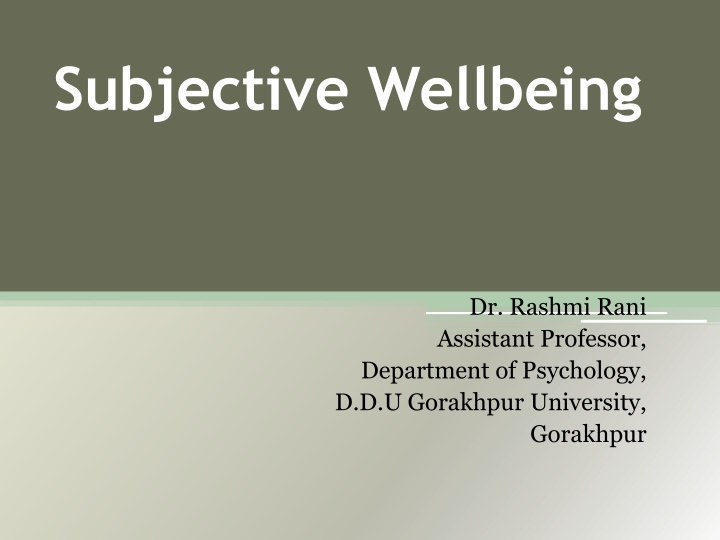
Subjective Well-Being: Components, Determinants, and Importance
Explore subjective well-being (SWB) from the perspective of cognitive and affective evaluations of life satisfaction, including its components, determinants such as psychological, physical, and cultural factors, and its significance for quality of life, human progress, and mental health.
Download Presentation

Please find below an Image/Link to download the presentation.
The content on the website is provided AS IS for your information and personal use only. It may not be sold, licensed, or shared on other websites without obtaining consent from the author. If you encounter any issues during the download, it is possible that the publisher has removed the file from their server.
You are allowed to download the files provided on this website for personal or commercial use, subject to the condition that they are used lawfully. All files are the property of their respective owners.
The content on the website is provided AS IS for your information and personal use only. It may not be sold, licensed, or shared on other websites without obtaining consent from the author.
E N D
Presentation Transcript
Subjective Wellbeing Dr. Rashmi Rani Assistant Professor, Department of Psychology, D.D.U Gorakhpur University, Gorakhpur
SUBJECTIVE WELL-BEING Subjective people experience and evaluate their lives and specific domains and activities in their lives. Subjective well-being is people s cognitive and affective evaluations of their lives Diener, E., & Fujita, F. (1995 ). well-being (SWB) refers to how Life satisfaction involves a favorable attitude towards one's life rather than an assessment of current feelings. Cognitive appraisal describes how we consider our global (overall) life satisfaction and our satisfaction with Specific domains (family life, career, and so forth). Affective appraisal concerns our emotional experience. High SWB is the experience of frequent and intense positive states (joy, hope, and pride) and the general absence of negative ones (anger, jealousy, and disappointment).
COMPONENTS OF SUBJECTIVE WELL-BEING SWB is most often thought of as having three components (Tov & Diener, 2013): Frequent positive affect Infrequent negative affect Cognitive evaluations of life satisfaction
DETERMINANTS OF SUBJECTIVE WELL BEING Psychological factors Stress Anxiety Depression Social support optimism Physical factors Autonomy Marriage Income Health Cultural factors Equality Individualism
Why Is SWB Important? There are many reasons why subjective wellbeing matters to individuals and society as a whole. Quality of life Human progress Mental health
QUALITY OF LIFE Our affective experiences and overall emotional wellbeing are central to our quality of life as individuals (Skevington & B hnke, 2018). People who feel satisfied with their lives and frequently experience good feelings and hope are more inclined to be seen as enjoying a high quality of life. such as joy, contentment, Measures of SWB can be used to inform policy decisions, academic curricula, and social initiatives that contribute to a better quality of life for citizens and communities across the world (OECD Better Life, 2013).
HUMAN PROGRESS Gross domestic product (GDP) alone is not an adequate measure of life quality at the national level, although research suggests that it may have some impact on SWB through various mechanisms (Diener, Tay, & Oishi, 2013). It is generally agreed that SWB offers a more comprehensive measure of a nation s wellbeing by extending the concept beyond merely material concerns and considering individual perspectives rather than outsider judgments.
MENTAL HEALTH Mental health is critical to SWB and vice versa. Very crudely, mental health can be considered the absence of negative psychological symptoms and the presence of positive ones (Abdel-Khalek & Lester, 2013). What s important to note here is that the absence of illness and disease is not considered enough for people to have good mental health, and it s where SWB comes into the definition.
SOME PSYCHOLOGICAL TESTS MEASURING SUBJECTIVE WELLBEING Scales measuring affect Positive and Negative Affect Scale (PANAS) Scale of Positive and Negative Experience (SPANE) scales measuring life satisfaction Satisfaction With Life Scale (SWLS) Oxford Happiness Questionnaire (OHQ)
POSITIVE AND NEGATIVE AFFECT SCALE (PANAS) The PANAS is a self-report questionnaire comprising two separate subscales, one measuring positive affect and one measuring negative affect (Watson, Clark, & Tellegen, 1988; Medvedev & Landhuis, 2018). Each scale includes 10 adjectives that relate to different affective states, such as hostile, alert, jittery, and proud. Using a 5-point Likert scale, where 1 is Not at all/Very Slightly and 5 is Extremely, participants rate the extent to which they feel each emotion.
SCALE OF POSITIVE AND NEGATIVE EXPERIENCE (SPANE) Another commonly used measure of affect, the SPANE, was developed by Diener et al. in 2009. It measures both pleasant and unpleasant emotional feelings, as well as other positive states, such as flow and engagement, physical pleasure, and interest. Similar to the PANAS, it works by presenting 12 adjectives that the participant considers; examples include joyful, afraid, and contented. All items are scored using a 5-point Likert scale that spans from 1 ( very rarely or never ) to 5 ( very often or always ). The positive feelings score (SPANE P) and negative feelings score (SPANE N) yield positive and negative figures, respectively, which allows you to calculate your overall affect balance score (SPANE B).
SATISFACTION WITH LIFE SCALE Satisfaction With Life Scale is a compact questionnaire for measuring global life satisfaction (Diener, Emmons, Larsen, and Griffin, 1985) . It looks specifically at the life satisfaction construct and doesn t include items for affect. With good internal consistency and temporal reliability, it consists of five statements where participants can indicate a level of agreement on a 7-point scale.
Oxford Happiness Questionnaire (OHQ) Hills and Argyle (2002) developed the OHQ as an improvement on the Oxford Happiness Inventory, which was being used at the time to measure SWB (Kashdan, 2004). Participants use a 1 6 scale to report how much they agree with 29 items, where 1 indicates the strongest disagreement possible and six, the strongest agreement.
REFERENCES Abdel-Khalek, A., & Lester, D. (2013). Mental health, subjective well-being, and religiosity: Significant associations in Kuwait and USA. Journal of Muslim Mental Health, 7(2), 63 76. Diener, E., & Fujita, F. (1995). Resources, personal strivings, and subjective well-being: A nomothetic and idiographic approach. Journal of Personality and Social Psychology, 68(5), 926 935. Diener, E., Emmons, R. A., Larsen, R. J., & Griffin, S. (1985). The Satisfaction with Life Scale. Journal of Personality Assessment, 49(1), 71 75. Diener, E., Tay, L., & Oishi, S. (2013). Rising income and the subjective well-being of nations. Journal of Personality and Social Psychology, 104(2), 267 276. Diener, E., Wirtz, D., Tov, W., Kim-Prieto, C., Choi. D., Oishi, S., & Biswas-Diener, R. (2009). New measures of well-being: Flourishing and positive and negative feelings. Social Indicators Research, 39, 247 266. Hills, P., & Argyle, M. (2002). The Oxford Happiness Questionnaire: A compact scale for the measurement of psychological well-being. Personality and Individual Differences, 33(7), 1071 1082. OECD Better Life. (2013). In search http://www.oecdbetterlifeindex.org/blog/in-search-of-satisfaction.htm Skevington, S. M., & B hnke, J. R. (2018). How is subjective well-being related to quality of life? Do we need two concepts and both measures? Social Science & Medicine, 206, 22 30. Tov, W., & Diener, E. (2013). Subjective wellbeing. In K. D. Keith (Ed.), The encyclopedia of cross-cultural psychology (pp. 1239 1245). John Wiley & Sons. Watson, D., Clark, L. A., & Tellegen, A. (1988). Development and validation of brief measures of positive and negative affect: the PANAS scales. Journal of Personality and Social Psychology, 54(6), 1063 1070. of satisfaction. Retrieved from


